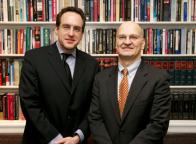On a frigid day in late January, Barton Beebe gave the inaugural lecture of the John M. Desmarais Professorship of Intellectual Property Law on “Intellectual Property Law and the Problem of Aesthetic Progress.” To a capacity crowd in Greenberg Lounge, he tackled the concept of aesthetic progress and whether it is in tune with our times.
Aesthetic progress, Beebe said, is under-examined within copyright law. The term itself does not have an exact definition, but comes from the general idea of something new, improved, or different about the way something looks, rather than the way it works.
While aesthetic progress is at best a murky legal concept, Beebe argued that now is the time to discuss its place in copyright law because we, the masses, spend so much of our time creating things, from puppy videos to musical mash-ups, where the “progress” may be more in the joy of creating than the relevance of the end product. Current copyright law, he said, ignores that process and is applied to the new creation only in its completed form.
The early 20th Century “would have been an especially appropriate time for intellectual property law to consider the relation between the aesthetic and progress,” Beebe said, especially following the Supreme Court’s 1903 Bleistein v. Donaldson Lithographic opinion, which held circus advertisements could receive copyright protection even if they were not fine art. The opinion, however, instead turned out to be a “conversation-stopper” on the topic, said Beebe.
In both statutes and case law, the stated purpose of intellectual property law is to promote progress in the arts and sciences. For both scientific and technological knowledge, progress means improving on the last thing, making something more efficient, or building something that replaces something new. Progress in the arts, however, doesn’t mean that the works of Picasso replace cave drawings, Beebe said.
Instead, the art is often something totally new, and part of the reason the artist creates it is for the joy of doing so. That creative process, however, has no value under current law.
“For two centuries, we have viewed copyright law essentially as industrial policy with long-term accumulation as its goal,” Beebe said. And while he conceded that’s a good thing, “we also need to view it as cultural policy with short-term, even immediate aesthetic experience as its competing goal.”
That doesn’t mean that judges should engage in “aesthetic discrimination,” nor does copyright law need to be turned on its head.
“But I am suggesting that we have every right ourselves, as the crowd, to promulgate a form of copyright law,” that might be more lenient in consideration of the way we live now, he said. For example, Beebe suggested it might be time to revisit enforcement of the reproduction right. That right gives copyright holders the sole right to reproduce their work and might prevent, say, the puppy video maker from using clips of others’ work to include in his own.
Opening up the conversation about aesthetic progress and what it means could lead to tweaks to copyright law that are more in line with the way we live now, Beebe said, even if the most recent relevant precedent is a century and a decade old.
John Desmarais ’88 is one of the country’s most successful intellectual property attorneys. He is the founding partner of Desmarais, and a former partner at Kirkland & Ellis. Dean Trevor Morrison gave opening remarks, describing Desmarais and Beebe as “towering figures in intellectual property law.” He also cited Desmarais’ dedication to the law school community and Beebe’s academic contributions, calling the professor a “multi-talented scholar who produces multi-faceted work.”
Watch the inaugural lecture of the John M. Desmarais Professorship of Intellectual Property Law (1 hr, 2 min) below:
Posted on February 3, 2014
